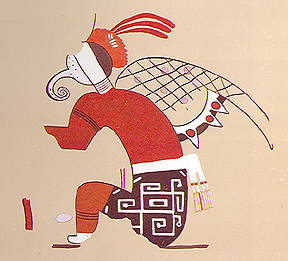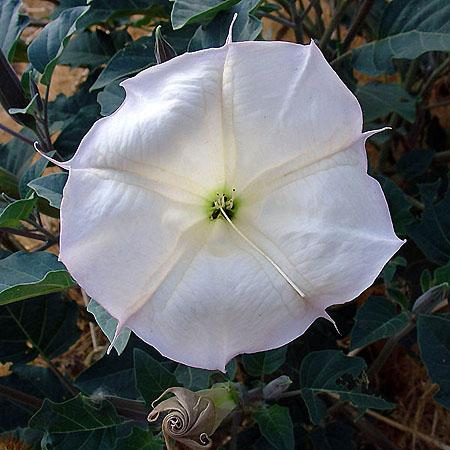
 |
Why do they come to me to die?
Moths.. they have been coming to me to die for several years now. I see them one night, and the next morning I am sweeping them up. This is an often occurrance, sometimes weekly, at least monthly. Even if I am away or on vacation.. when i last traveled I found two dead moths in the corner in my sister's house my first morning, they were not there the night before. Why do they come to me?
 |
 What prompted the depiction of this strange human-insect hybrid? One of the archaeological interns who originally excavated Pottery Mound and helped to copy its murals has put forth an intriguing theory. In a poster presentation at the Society for American Archaeology conference, March 2005 in Salt Lake City, Utah, independent researcher and anthropologist Paul T. Kay provided some interesting links between the night flying hawk moth (Manduca sexta, also called sphinx moth) and the Datura plant. "There exists a mutualistic relationship in nature between the hawk moth and the Datura plant. ALL of this is related to the widespread ritualistic use of Datura during SHAMANISTIC practices..." [3] The pink-spotted hawk moth (Agrius cingulata) may also have been intended. Datura wrightii is known as devil's weed, thorn apple, or jimsonweed. The latter term is a corruption of "Jamestown weed," after the Virginia colony where Europeans first unwittingly ingested a similar species. This perennial grows throughout the American Southwest in open land with well-drained soil. Its nocturnally blooming, white trumpet-shaped flowers are pollinated by the hummingbird-sized hawk moth, which inserts its long proboscis into the fragrant flower tube to reach the profuse nectar. Kay furthermore believes that the classic plumed serpent traditionally depicted on ceramics, murals, and rock art is actually the instar, or larva, of this moth. The only problem with this part of Kay's theory, however, is that the 'horn' is at the posterior, not the head. Ancient Pottery Mound inhabitants would surely have known this. Datura is a powerful and dangerous hallucinogen. [4] It has been used both medicinally and ritually for at least 4,000 years in the Southwest. Ground-up portions of the plant were sometimes employed as an anesthetic or as a salve for wounds or bruises. The Aztecs called it toloatzin, which means "nodding head." This refers to the seedpods but may as well mimic the unconscious head of one who has ingested the psychotropic plant. The Navajo have a folk adage regarding this poisonous tropane alkaloid of the nightshade family: "Eat a little, and go to sleep. Eat some more, and have a dream. Eat some more, and don't wake up." Symptoms of Datura intoxication include dizziness, flushing, fever, dilated pupils, temporary blindness, dry skin and mouth, difficulty swallowing, tachycardia, heightened sexuality, restlessness, inability to concentrate, idiosyncratic or violent behavior, delirium, visual and auditory hallucinations, sometimes terrifying phantasmagoria, inability to distinguish fantasy from "reality," and amnesia.  Blossom of Datura wrightii. Blossom of Datura wrightii.Andrew Weil highlights the negative aspects of the plant: "Datura is not a nice drug. Although sometimes classified as a hallucinogen, it should not be confused with the psychedelics. It is much more toxic than the psychedelics and tends to produce delirium and disorientation. Moreover, Datura keeps bad company. All over the world it is a drug of poisoners, criminals, and black magicians." [6] For the indigenous people of the Andes in Peru, Datura is known as yerba de huaca, or 'herb of the graves'. This is because its use allowed communication with the spirits of ancestors. [7] Many tribes of the western U.S. have traditionally incorporated the Sacred Datura into their religious rites. "Societies in the Great Basin and in much of California also used the plant, where it was commonly employed in vision quests for spirit helpers and in boys' initiation rites... Ritual uses include initiation, divination, good luck, and transport to the spirit world for other purposes. Shamanic healers have exploited the plant's mind-altering qualities to diagnose illnesses in patients." [8] Zuni priests of New Mexico used Datura to communicate with birds and petition them for rain. "In 1879 the writer discovered that the Zunis employed a narcotic... found to be Datura stramonium or jimson weed... when the rain priests go out at night to commune with the feathered kingdom, they put a bit of powdered root into their mouth so that the birds may not be afraid and will listen to them when they pray to the birds to sing for the rains to come." [9] Extracts or derivatives of Datura mixed with the fat of a wild boar are sometimes used in a paste known as a "flying ointment." Anthropologist and author Carlos Castaneda, during his tutelage with the Yaqui shaman and diablero don Juan Matus, recounts his teacher's intimate knowledge of Datura to accomplish psychic flight: "The second portion of the devil's weed [the root] is used to fly... The unguent by itself is not enough. My benefactor said that it is the root that gives direction and wisdom, and it is the cause of flying. As you learn more, and take it often in order to fly, you will begin to see everything with great clarity. You can soar through the air for hundreds of miles to see what is happening at any place you want, or to deliver a fatal blow to your enemies far away. As you become familiar with the devil's weed, she will teach you how to do such things." [10]In this case the plant itself is referred to as a feminine ally who is actually conscious. Castaneda asks whether his own body actually flew like a bird, and don Juan replies: "A man flies with the help of the second portion of the devil's weed. That is all I can tell you. What you want to know makes no sense. Birds fly like birds and a man who has taken the devil's weed flies as such [el enyerbado vuela as’]." "As birds do? [Así como los pájaros?]." "No, he flies as a man who has taken the weed [No, así como los enyerbados]." [11] Several jimsonweed seeds were actually found in a deeply buried room floor at Pottery Mound. In addition, small ceramic effigy vessels have also been discovered in the region. Conical bumps on their outer surface resemble the spiny seedpods. They may have been used either to store the seeds or as a cup for the Datura brew. A menacing anthropoid painted on the interior of a different type of flat pottery bowl has a body that resembles the plant's round, prickly seedpod. He has half-moon eyes, a rectangular mouth with teeth, and red hair or headdress. This last feature may correspond to the red headpiece of the first Mothman mural shown above. Members of Hopi Fire Clan (Ko'kop) were also known as 'the redheads'. As the most aggressive Hopi clan, it founded the Warrior Society named Motswimi. According to one historian, these redheads were also the traditional enemies of the Aztecs. [12] The Fire Clan is furthermore associated with an ominous being named Masau'u, the Hopi god of death, war, and the underworld. The figure depicted on the ceramic resembles some of the Hopi rock art renditions of this god. Interesting in this context is the Hopi word for 'moth': masivi. This word has the same root as the name of the Hopi death god, which literally means 'gray' -- the color of moth wings. One Hopi synonym for 'moth' is even more intriguing: Tsimonmana specifically refers to "a type of moth attracted to jimsonweed." This word literally means 'jimsonweed maiden' [13], thereby echoing the feminine designation of Datura that we find in Yaqui culture. Some Hopi legends do indeed describe pairs of licentious young femme fatales who wear Datura blossoms in their hair while they seduce and harm unsuspecting males. We thus have the moth and jimsonweed contained in the single Hopi word, Tsimonmana. |
Because you are a beacon of light! Really, you're man's last hope, y'know?
|
Quote:
fun and jokes aside this is seriously tripping me out.. it happens ALL the time. what would you think if they came to you to die? |
so, if we're to believe the indians, knowledge comes to you to die?
for me, it's ants. I see them, I squish them, they die. |
For me it's cockroaches.
|
 So Wayne, I hear you're putting on some kind of concert. That's good. People need to be entertained, they need the distraction. I wish to God that someone would be able to block out the voices in my head for five minutes, the voices that scream, over and over again: "Why do they come to me to die? Why do they come to me to die?" |
Quote:
"It is it." |
i like moths.
|
If it's the snake in your sign talkin', than that's a given.
|
They like landing and dying on my washing that I'm trying to bring in from the clothesline. Especially this one shirt, that I don't like to hang outside because I KNOW the bugs love it too much for some weird reason.
This morning there was one dead in a sock I wanted to wear. |
Bug pheromones in your clothes?
|
perhaps..
? |
moths ussually die after fuckin, right?
maybe they come to you for post-coitus cuddling. |
carlos casteneda is the biggest pile of crap i've ever read
|
worse than anne rice?
|
Quote:
YOU FOUND THE REFERENCE! hilarious! Quote:
why does it not have to be symbolism? I didn't think so much of it there first few years but it has really been getting surreal lately. Again, what would you think if they came to you? Its not that I kill them, I just see them, and then later I find them dead. They fly around my house/room for a few days, then I find their bodies and sweep them up. But it just doesn't make any sense.. Quote:
yes and no. Castaneda writes a long novel based upon real life events. If you have ever reasoned with Yaqui indians, you will find that Castaneda was not far off.. the problem is that he wrote a mystical text trying to pass it off as anthropology. Using Castaneda for anthropology is like trying to use the Bible to understand details the Israeli-Palestinian conflict. |
| All times are GMT -5. The time now is 05:49 PM. |
Powered by vBulletin Version 3.5.4
Copyright ©2000 - 2024, Jelsoft Enterprises Ltd.
All content ©2006 Sonic Youth